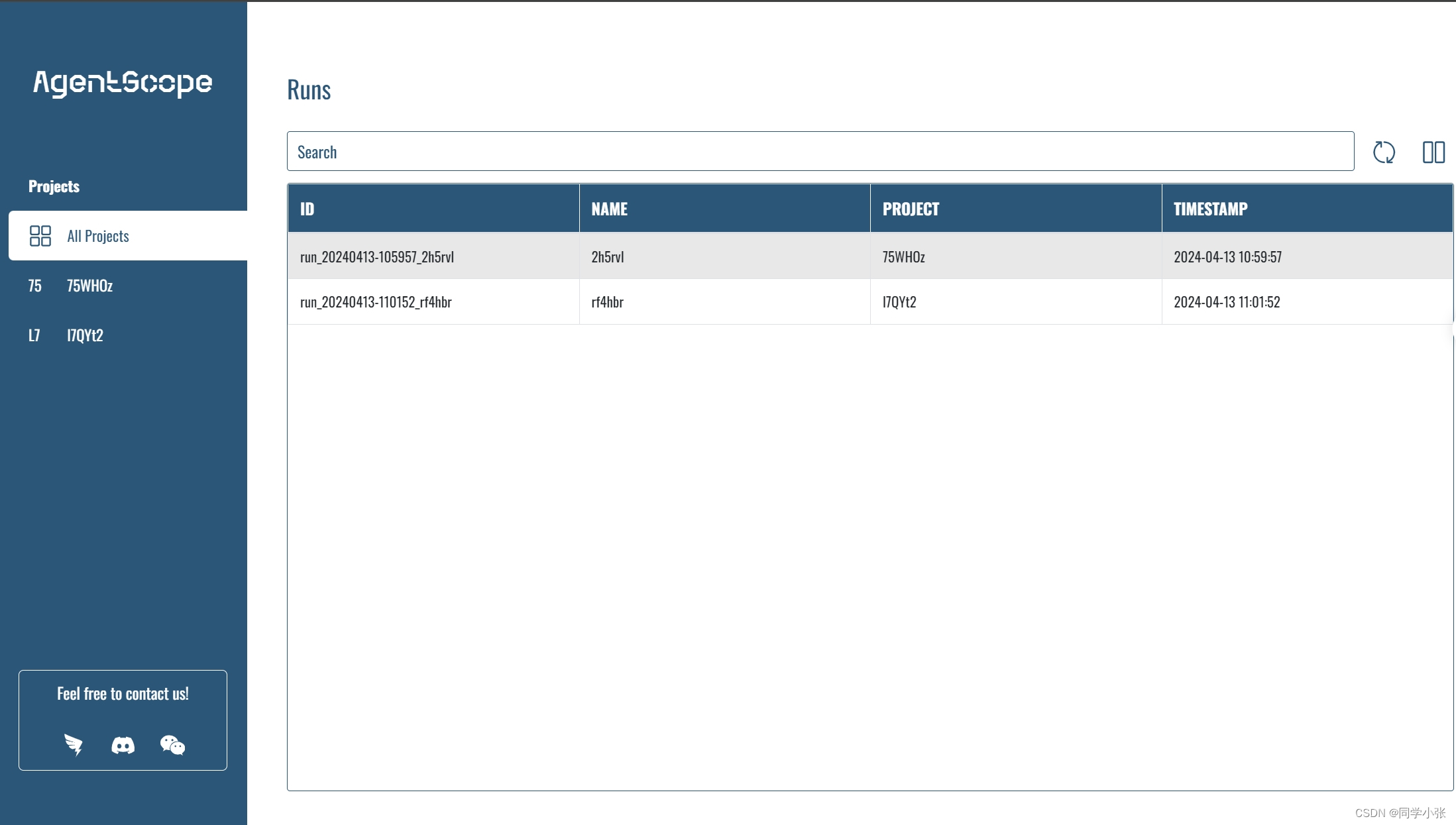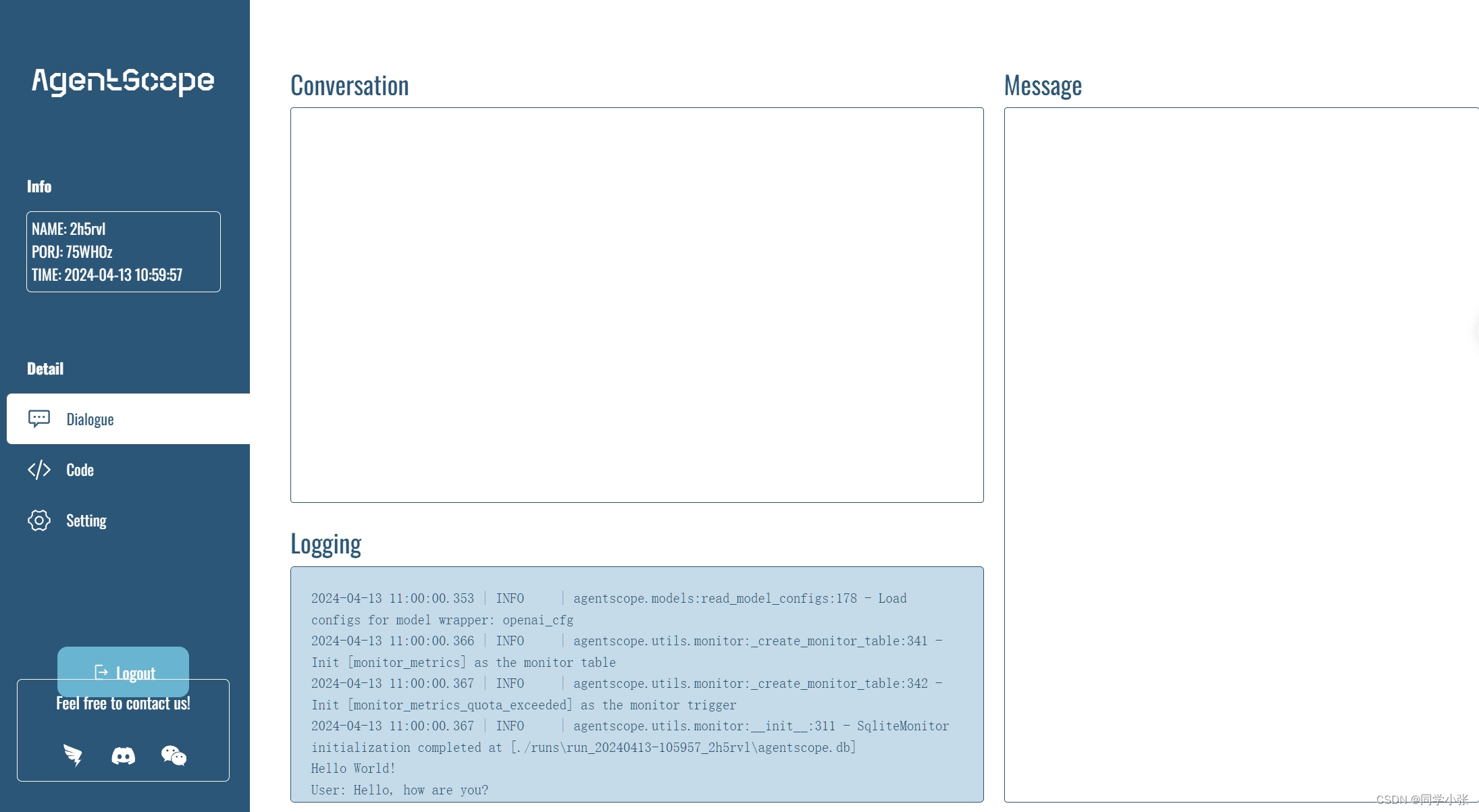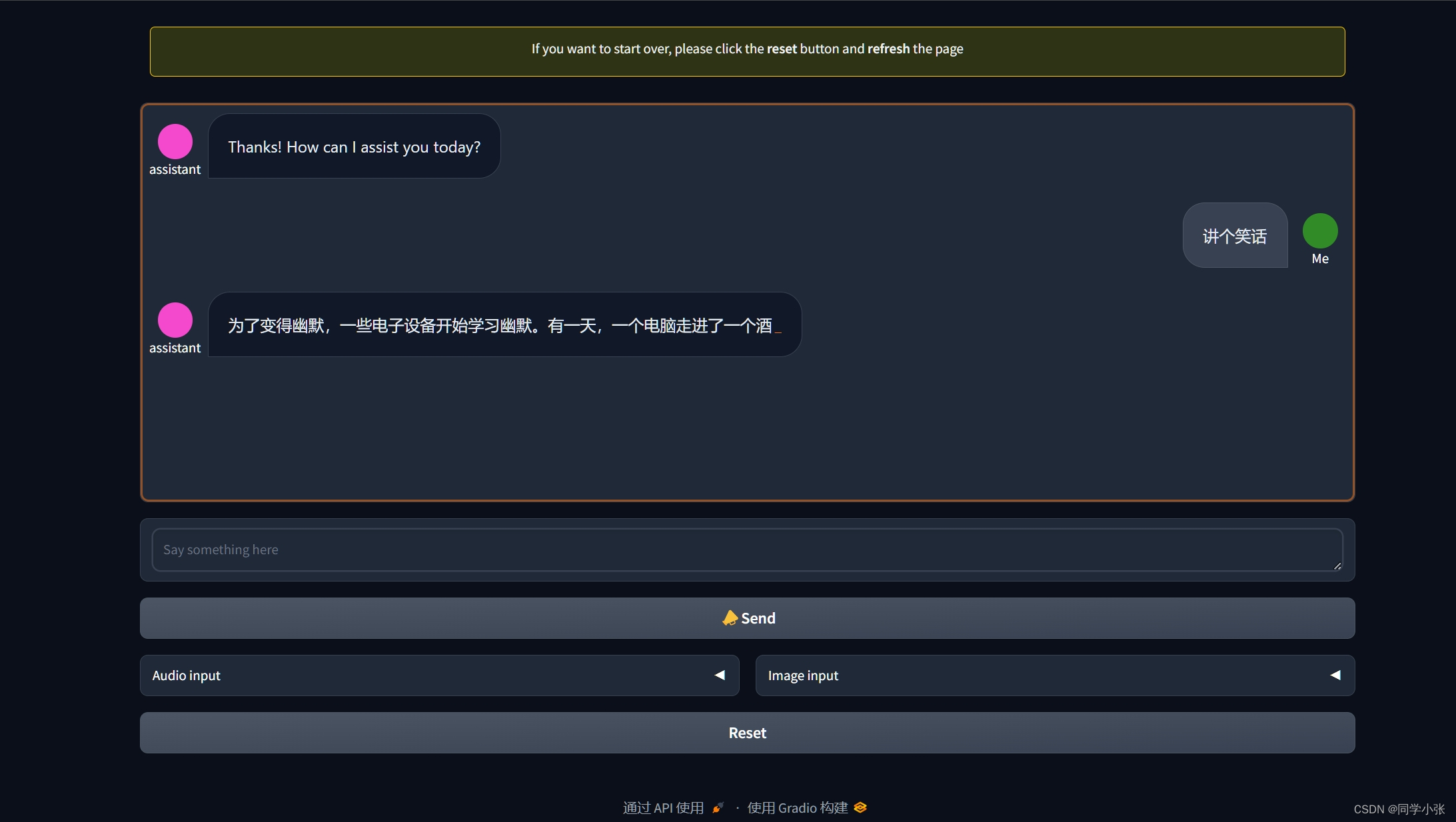【AI Agent系列】【阿里AgentScope框架】6. 可视化:AgentScope的日志和WebUI模块使用介绍
大家好,我是 同学小张,持续学习C++进阶知识和AI大模型应用实战案例,持续分享,欢迎大家点赞+关注,共同学习和进步。
阿里的AgentScope框架比其它多智能体开发框架友好的一点就是,它可以让你的程序运行过程可视化,让你能可视化地记录和查看到程序运行的详细过程及日志,便于排查问题和调试。
类似 LangChain 的 LangSmith 和 Langfuse平台,只不过现在还不成熟。
文章目录
- 0. 日志模块
- 1. WebUI可视化
- 1.1 使用方法
- 1.2 实现原理
- 1.2.1 实现框架
- 1.2.2 展示项目的原理
- 1.2.3 展示详细日志的原理
- 1.3 从一些坑看其实现原理
- 1.4 实时对话框UI
0. 日志模块
参考官方文档:https://modelscope.github.io/agentscope/zh_CN/tutorial/105-logging.html#logging-zh
(1)日志模块的引入
from loguru import logger
(2)日志模块的等级
LOG_LEVEL = Literal[ "CHAT", "TRACE", "DEBUG", "INFO", "SUCCESS", "WARNING", "ERROR", "CRITICAL", ](3)日志记录的设置
通过 init 函数来设置日志开启的等级
agentscope.init(..., logger_level="INFO")
(4)一般日志记录(系统日志)
通过 info、warning、error等函数来记录系统日志。
# Log general information useful for understanding the flow of the application. logger.info("The dialogue agent has started successfully.") # Log a warning message indicating a potential issue that isn't immediately problematic. logger.warning("The agent is running slower than expected.") # Log an error message when something has gone wrong. logger.error("The agent encountered an unexpected error while processing a request.")(5)对话消息记录
AgentScope额外提供chat接口来记录对话消息,用来追踪智能体之间的对话。
# Log a simple string message. logger.chat("Hello World!") # Log a `msg` representing dialogue with a speaker and content. logger.chat({"name": "User", "content": "Hello, how are you?"}) logger.chat({"name": "Agent", "content": "I'm fine, thank you!"})1. WebUI可视化
WebUI用来将上述记录的日志进行可视化。
1.1 使用方法
只需要下面几行代码,运行即可:
注意只需要下面几行代码,不要插入到其它代码里,新开一个文件,单独运行下面几行。
import agentscope agentscope.web.init( path_save="D:\\GitHub\\LEARN_LLM\\runs" )运行后:
浏览器打开 127.0.0.1:5000,可以看到如下界面:
点击进入某一个具体的ID后,会看到详细的日志记录:
1.2 实现原理
1.2.1 实现框架
WebUI模块部分源码如下:
from flask import Flask, jsonify, render_template, Response from flask_cors import CORS from flask_socketio import SocketIO app = Flask(__name__) socketio = SocketIO(app) CORS(app) # This will enable CORS for all routes
可以看到其实现原理是使用Flask框架,将前端与后端链接起来获取数据展示数据。
1.2.2 展示项目的原理
看下其加载数据的源码:
@app.route("/getProjects", methods=["GET"]) def get_projects() -> Response: """Get all the projects in the runs directory.""" cfgs = [] for run_dir in os.listdir(PATH_SAVE): print(run_dir) path_cfg = os.path.join(PATH_SAVE, run_dir, ".config") if os.path.exists(path_cfg): with open(path_cfg, "r", encoding="utf-8") as file: cfg = json.load(file) cfg["dir"] = run_dir cfgs.append(cfg) # Filter the same projects project_names = list({_["project"] for _ in cfgs}) return jsonify( { "names": project_names, "runs": cfgs, }, )这个接口用来获取并展示所有运行过的项目。其实现原理是加载日志路径里面的文件(这个日志路径有坑,后面细说)。
1.2.3 展示详细日志的原理
用来获取和展示详细日志的源码如下,根据传进来的日志路径,读取文件内容,返回并展示:
@app.route("/run/") def run_detail(run_dir: str) -> str: """Render the run detail page.""" path_run = os.path.join(PATH_SAVE, run_dir) # Find the logging and chat file by suffix path_log = os.path.join(path_run, "logging.log") path_dialog = os.path.join(path_run, "logging.chat") if os.path.exists(path_log): with open(path_log, "r", encoding="utf-8") as file: logging_content = ["".join(file.readlines())] else: logging_content = None if os.path.exists(path_dialog): with open(path_dialog, "r", encoding="utf-8") as file: dialog_content = file.readlines() dialog_content = [json.loads(_) for _ in dialog_content] else: dialog_content = [] path_cfg = os.path.join(PATH_SAVE, run_dir, ".config") if os.path.exists(path_cfg): with open(path_cfg, "r", encoding="utf-8") as file: cfg = json.load(file) else: cfg = { "project": "-", "name": "-", "id": "-", "timestamp": "-", } logging_and_dialog = { "config": cfg, "logging": logging_content, "dialog": dialog_content, } return render_template("run.html", runInfo=logging_and_dialog)1.3 从一些坑看其实现原理
(1)这个WebUI不是实时显示程序运行结果的,它只是一个运行日志查看平台。
(2)如果运行了程序,而在WebUI中却没有看到你的这次运行,那么,请检查你WebUI的设置路径:
官方文档中只说了这里填"YOUR SAVE PATH",但是很坑的是,这里的SAVE PATH,指的是已经保存过的日志的路径。
在我们真正的程序中,刚开始都要进行init:
agentscope.init(model_configs=[openai_cfg_dict], logger_level="INFO")
而这个保存路径就隐藏在这个函数里,我之前并没有注意到(下面代码中的save_dir):
def init( model_configs: Optional[Union[dict, str, list]] = None, project: Optional[str] = None, name: Optional[str] = None, save_dir: str = _DEFAULT_DIR, save_log: bool = True, save_code: bool = True, save_api_invoke: bool = True, logger_level: LOG_LEVEL = _DEFAULT_LOG_LEVEL, agent_configs: Optional[Union[str, list, dict]] = None, ) -> Sequence[AgentBase]:代码中的save_dir,默认是 _DEFAULT_DIR = "./runs",也就是工程目录下的./runs文件夹下。这才是真正的日志记录的位置。WebUI init 时的 path_save 路径,必须与这里的路径相同,否则它是加载不到这些日志的。
1.4 实时对话框UI
上面的WebUI是用来看日志的,非实时,也不能编辑。
AgentScope还提供另一种UI界面,实时对话。使用命令 as_studio 要运行的py即可:
as_studio .\agentscope\start_0\start_agentscope.py
注意:运行的py文件一定要以main函数开始,要存在main函数
运行后的效果:
浏览器打开这个网址:
就可以在输入框直接对话了。后台程序同时会进行日志输出:
如果运行报错 NoneType:
则很可能是你的环境不全,需要安装 gradio 和 modelscope_studio
pip install -U gradio -i https://pypi.tuna.tsinghua.edu.cn/simple pip install -U modelscope_studio -i https://pypi.tuna.tsinghua.edu.cn/simple
如果觉得本文对你有帮助,麻烦点个赞和关注呗 ~~~
















